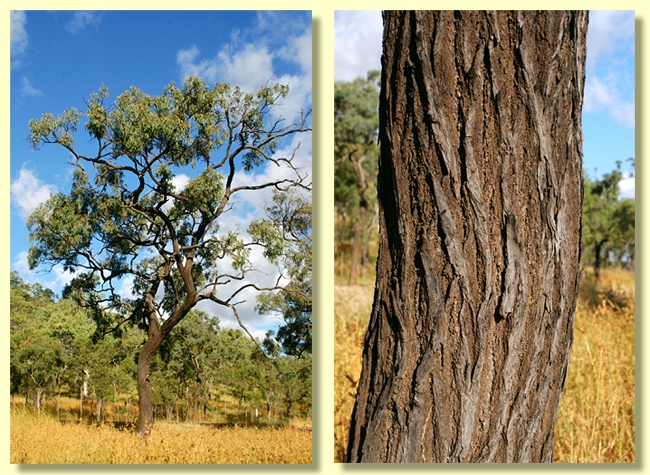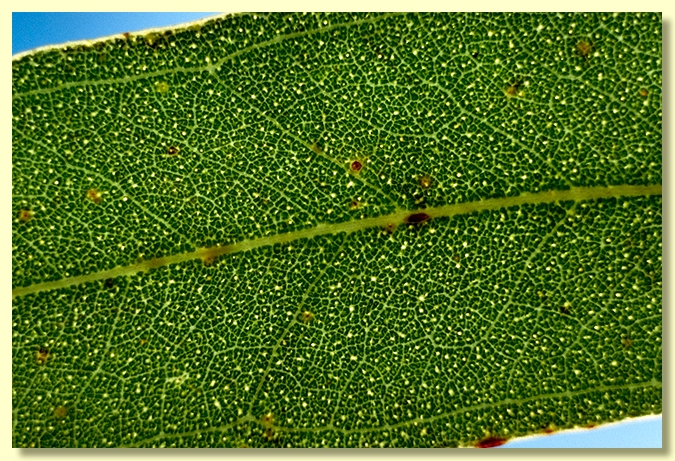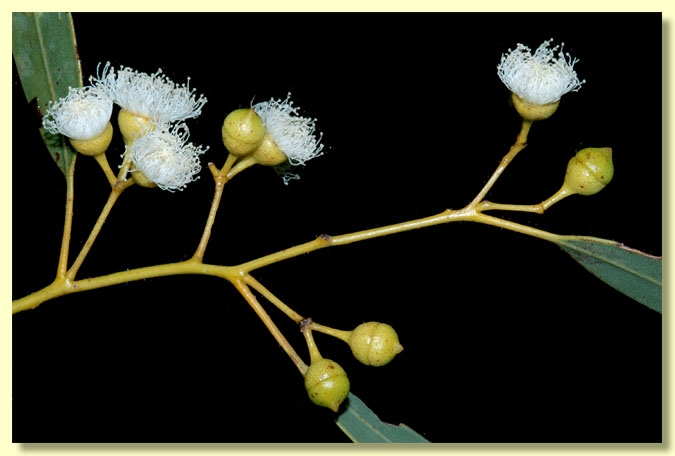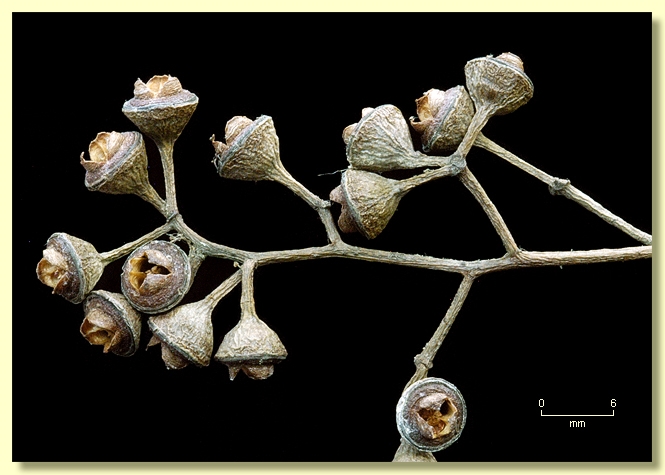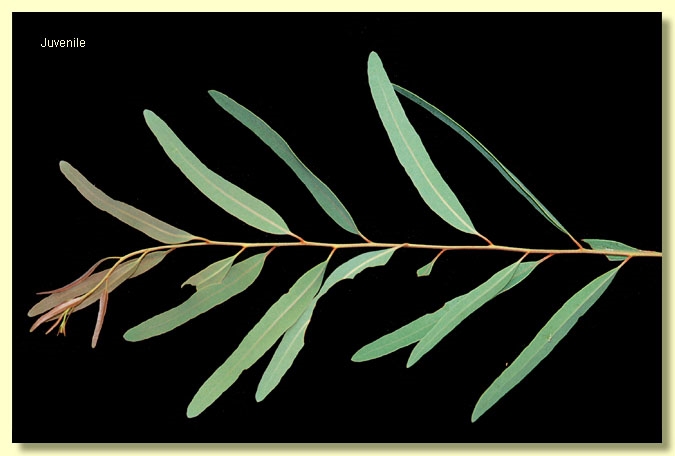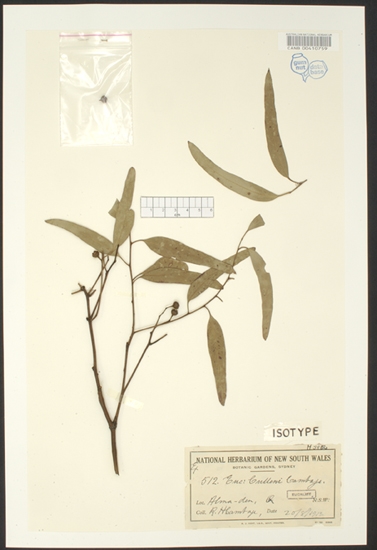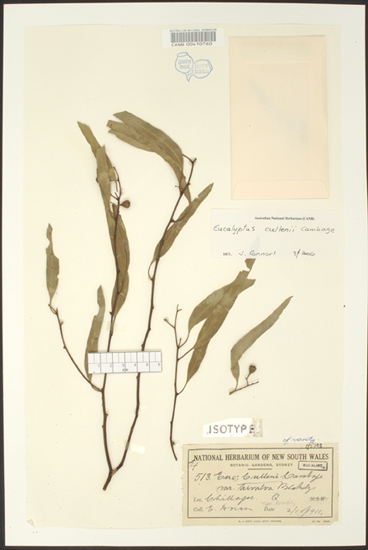Euclid - Online edition
Eucalyptus cullenii
Eucalyptus | Symphyomyrtus | Adnataria | Apicales | Siderophloiae | Subglaucae
Eucalyptus cullenii Cambage, J. & Proc. Roy. Soc. New South Wales 54: 48, t. 1 (1920).
T: Queensland: Alma-den, 20 Aug 1913, R.H.Cambage 3905; holo: NSW; ?iso: CANB.
Tree to 15 m tall, occasionally taller to 25 m. Forming a lignotuber.
Ironbark to small branches, dark grey or black.
Juvenile growth (coppice or field seedlings to 50 cm): stem rounded or square in cross-section, normally non-glaucous, rarely glaucous; juvenile leaves opposite for a few pairs, then alternate, petiolate, linear to narrowly lanceolate, 4–11 cm long, 0.4–1.5(2.2) cm wide, dull grey-green to green or rarely glaucous.
Adult leaves alternate, petiole 0.7–1.7 cm long; blade narrowly lanceolate to lanceolate, rarely linear, (5.5)7–15(19) cm long, 0.8–1.5(2.5) cm wide, base tapering to petiole, concolorous, dull, green to grey-green, to rarely slightly glaucous, side-veins at an acute or sometimes wider angle to midrib, densely to very densely reticulate, intramarginal vein parallel to and just within margin, occasionally confluent with the margin, oil glands mostly intersectional, sometimes sparse.
Inflorescence terminal compound or axillary compound, or axillary single umbels, peduncles 0.5–2 cm long, buds 7 per umbel, rarely only 3, pedicels 0.3–0.7 cm long. Mature buds obovoid to globular to pear-shaped, 0.4–0.6 cm long, 0.3–0.4 cm wide, green to yellow, smooth, scar present, operculum rounded, sometimes shallowly beaked, stamens usually irregularly flexed, anthers adnate, cuboid, dehiscing by broad lateral pores or slits, style long, stigma blunt or pin-head shaped, locules usually 4, rarely 3, the placentae each with 4 vertical ovule rows. Flowers white.
Fruit pedicellate (pedicels 0.2–0.7 cm long), hemispherical, 0.2–0.4 cm long, 0.4–0.8 cm wide, disc broad, level with the rim or slightly ascending, valves 4, near rim level or slightly exserted.
Seeds dark brown or grey, 1.8–2.2(2.5) mm long, ovoid or flattened-ovoid or pointed at one end, dorsal surface shallowly pitted, hilum ventral.
Cultivated seedlings (measured at ca node 10): cotyledons reniform to oblong; stems square in cross-section; leaves always petiolate, opposite for ca 2–3 nodes then alternate, linear, 4.5–9 cm long, 0.3–0.5 cm wide, base tapering, dull, green to grey-green.
Flowering has been recorded in January, February, March, April and May.
A small to medium-sized ironbark endemic to North Queensland from Horn Island at the tip of Cape York Peninsula, south to the Weipa area and then further south through the eastern side of Cape York as far as the Georgetown – Mt Surprise area, with possibly two further occurences in the Laroona–Ewan area and the Castle Hill area near Townsville. Characterised by its globular to obovoid buds with a rounded operculum, its hemispherical fruit with a broad flat to slightly ascending disc and linear to narrowly lanceolate juvenile leaves.
Eucalyptus cullenii is probably closest to E. atrata and E. paedoglauca, with all three species possessing a relatively broad disc on the fruit and buds with a rounded operculum. E. atrata and E. paedoglauca differ by having longer more elongated buds, with the operculum often narrower than the hypanthium, giving an egg-in-eggcup look. E. cullenii has ± globular buds with the operculum slightly constricted at the join with the hypanthium but usually not narrower than the hypanthium. E. atrata and E. paedoglauca differ further by having broadly lanceolate to ovate juvenile leaves.
Within its area of occurrence, E. cullenii could be confused with E. crebra, E. staigeriana, E. granitica, and E. whitei. It differs from all four by the disc of the fruit which is broad and flat to slightly ascending in E. cullenii but narrow and descending in the other four. E. staigeriana can be further separated by having a strong lemon smell in the crushed leaves. E. granitica can be further separated by having glossy green adult leaves. Intergrades between E. cullenii and E. crebra are common in places where the two taxa overlap in distribution.
MORE ABOUT IRONBARKS
Eucalyptus cullenii: after Sir William Portus Cullen (1855–1935). William Cullen had a notable academic career in Sydney where he won the University, Lithgow, Barker and Renwick Scholarships and the John Smith prize. He was called to the bar in 1883 and specialised in equity. He entered New South Wales politics in 1891 as MLA for Camden and in 1894 was appointed to the Legislative Council. He was Chief Justice of New South Wales from 1910 to 1925 and Lieutenant-Governor from 1910 to 1930.

